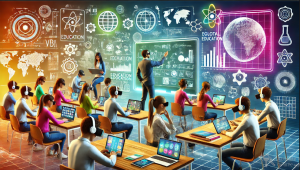Transforming Learning for a Digital Age

last century, one of the most drastic transformations has been witnessed: education. Digital tools in the classroom, online platforms, and self-paced learning environments have transformed the delivery of knowledge while significantly increasing its accessibility and inclusivity.
1. Personalized Learning through Technology
The most crucial role that technology plays in education is content tailoring. The adaptive learning platforms and AI-powered tutors are meant to study a student’s progress, profile, and then tailor the content according to their learning speed and style.
Khan Academy and similar are launching tailored exercises on the basis of students’ performances.
2.Expanding Education Opportunities
Technologies leveled the playing ground for any disadvantaged or a remote-area learner. Consider:
Millions of people can access high-class courses through Coursera, edX, and Udemy.
Offline-first solutions like Kio Kits bring digital content to students with poor internet connectivity.
3.Engaging and Interactive Content
The application of multimedia, virtual reality (VR), and augmented reality (AR) in educational learning offers exciting learner experiences.
The VR systems, such as ClassVR, allow children to visit history sites or scientific simulations.
AR applications offer digital information on top of the real world and enables complex subjects, such as anatomy or architecture, to be approached.
4. Motivation through Gamification
Gamification is applying game mechanics such as points, leaderboards, and challenges in order to boost engagement.
5.Collaborative Learning and Global Connectivity
Collaborative learning will be promoted by tools such as Google Workspace and Microsoft Teams; realtime connectivity enables an environment where collaboration of projects across geographical regions is done; learners engage with one another all around the globe through social media and forums, hence broadening the scope for cross-cultural exchange and widening perspectives.
6.Teacher Empowerment
Technology equips teachers with
Automation of administrative work, such as grading, by making use of resources like Google Forms
Professional growth support through webinars and online forums.
7.Challenges Technology in Schools Encounters
While there are some benefits that schools can experience from the implementation of technology, technology implementation in schools is not without its challenges:
Digital Divide: Not all of the students have access to devices or even a stable internet connection.
Time spent on screens issues: Excessive use of digital tools negatively affects health by causing eye strain or minimal physical activity.
Data Privacy: The student information is becoming gradually more prone to risks with security lost in the digital world.
8.Future Trends
New technologies such as artificial intelligence, blockchain, and 5G networks will shape education once again in the near future:
Artifcial intelligence systems may replace standardized testing by cumulative assessments.
Blockchain may secure academic credentials; therefore, fraud can be minimized.
5G will enable superb, real-time content delivery in remote areas difficult to access.
Conclusion
In fact, technologies in education have opened up umpteen possibilities to provide personalized, engaging, and globally connected learning experiences. Integration, though, needs to be perceptive so that it addresses challenges such as building inclusivity and effectiveness. The role of education in shaping the future of learning is something that will continue to evolve along with technology.


